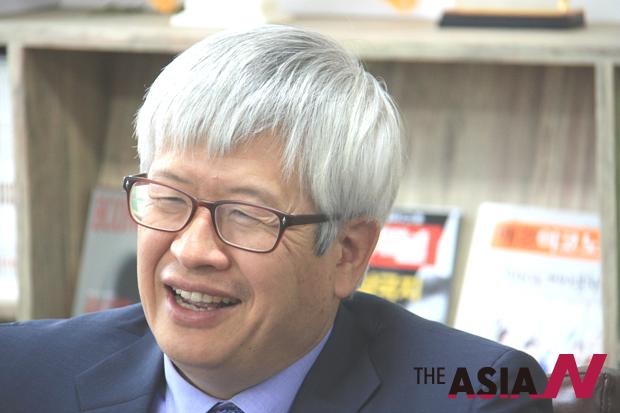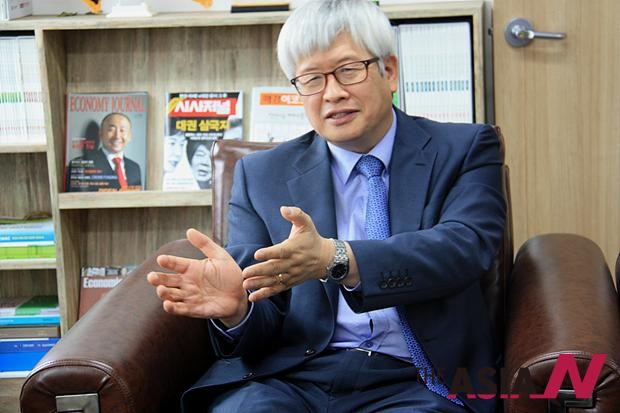“Creating the Next Hallyu with Energy Technology”
<Interview> President Nam-sung Ahn of the Korea Institute of Energy Technology Evaluation and Planning CallsClean Energy an “Inevitable Trend of the Day”
“I got the idea while watching Girls’ Generation’s performance. I thought there’s no need to confine Hallyu to popular culture. Why not tap into the world market with energy technology?”
Nam-sung Ahn, the president of the Korea Institute of Energy Technology Evaluation and Planning(KETEP)elaborated onK-ET(Korean Energy Technology), KETEP’s flagship project with a tinge of enthusiasm at his office on the 7th floor of the KETEP building in the morning of September 28. Borrowed from K-Pop, the term K-ETstands for Korean Energy Technology Hallyu Project.
With an extensive, decades-long background in the energy sector, Ahn reeled off his in-depth insight on energy throughout the interview. He had a heightened interest in the latest economy and business management concepts such as ‘Creating Shared Value (CSV)’. He particularly seemed to put extra effort into raising public awareness about energy technology, a topic thatis commonly considered stiff or difficult, by marrying it tosocial science and the humanities. The following is question and answerexchange with Ahn.
– Since the 2008 global financial crisis and the fiscal crisis that followed, investment andinterest in new and renewable energyseems to have dwindled around the world.
▲ When it comes to new and renewable energy, Europe used to be a standard bearer and a role model for the rest of the world. It is true that the industry is faltering due to financial crisis. In the US, the rise of shale gas as an alternative source of energy dealt a heavy blow to the wind power industry. I believe wind power and solar power parts suppliers have taken a direct hit.
– It’s hard to understand that governments and the private sector are reluctant to invest in alternative energy, citing the hard economic times, when the price of fossil fuels is skyrocketing.
▲ That is because just like any other conventional fuels, the new and renewable energy industry requires subsidies. The price is crucial but since new and renewable energy technologyis costly, they need subsidies to offset the high cost, which allows a smooth production and reinvestment flow and technological advance. This will make it a viable source of alternative energy.But many governments nowadays are tightening the purse strings under a tough economy, which has led the industry to suffer.
– Is the trend likely to continue?
▲ Well, it may for a while but I’d say it cannot escape ‘the trend of the times’. Especially, in the R&D sector, there won’t be any going backwards. R&D is about investing for the long run, in five or ten years from now, rather than making products right away.
The Korean government has put in 300 billion won into R&D for the new and renewable energy industry every year and 200 billion won for the energy distribution sector. I think the amount will stay at the same level down the road.
– Some claim new and renewable energy is not competitive with traditional fossil fuels because of a high generating cost.
▲ That is not true. Any type of energy infrastructure requires a massive amount of subsidies. The same goes for refined oil, gas, coal and nuclear energy. At the moment, fossil fuels are the least expensive options because infrastructure for gas or oil is already in place. It is only fair to compare generating costs after putting the same amount of subsidies and commercializing the technology.
– Can new and renewable energy take root under a steady government commitment?
▲It’s critical to lower the cost, which can be achieved in two ways, by innovating technology and looking at a business model. In terms of technological innovation, solar power and wind power have reached a separation point on an S-curve, with no clear policy in place.
We should solve this issue with a new business model.Technology for new and renewable energy is already out there.In order to lower the actual cost, we should take a business approach in the areas of site selection, project financing and customer contact. If support is made on the R&D front, for example, by customizing site surveys by region and studying financing, there definitely will be progress. This is where KETEP comes in.
– You used the term ‘thetrend of the times’ in explaining energy transformation.
▲The current situation dictates the low cost of fossil fuels. This is a result of pouring an enormous amount of government grants for the past decades.Now, we’re doing the same thing for new and renewable energyand making it a reliable energy system.This is why I mentioned ‘thetrend of the times’, which, by the way, is undeniable. The industry may fall back for a while but you can’t go against today’s larger trends,regardless of who governs the next administration.
– In his recent book <The Third Industrial Revolution>, Jeremy Rifkin said“New energy comes together with new communication systems”.
▲ Yes. We’re living an era of social values. Companies that once ruthlessly pursued profitsare now adapting ‘Creating Shared Value(CSV)’as their new vision in sustainable management. When there is a technological breakthrough in one sector, other sectors always follow suit. We can assume the same scenario for energy. Four systems, namely, energy, transportation, power and communication are closely knit with one another.
The underlying characteristics that define the era of natural energy, energy efficiency maximization andrenewable energy are distributed power system, small-sized power utilities, locally-driven energy production and distribution and environmentally-friendly energy.
It may not be a 100% conversion, but there will certainly be a transformation and innovation towards these types of energy system. The day where people sell and buy power on the Internet may arrive sooner than we expect. This is what I meant by‘thetrend of the times’.
– In Korea, clean energy policies seem to have come to a temporary halt, when we look at the recent move to build additional coal-fired power plants. Are oil refiners who have long lobbied against the development of clean energy pulling strings here?
▲If we continue to support and fosterthe new and renewable energy industry with policies, it will certainly outdo fossil fuels. But currently, we can’t afford to start from scratch by turning away fromthe existing energy infrastructure. We need a strong backbone to build muscles across our body. In reality, coal may account for 50% of power generation by year 2100. I think Korea should maintain a balanced portfolio where there’s a mix of oil, gas and nuclear power and room for growth, in this case,new and renewable energy. In fact, Korea has low wind and solar potential that are major sources of natural energy. We need continuous technological development and a clear business model to reach our goal of expanding new and renewable energy to 11.5% of the entire energy sources.
– You’re an advocate of K-ET that may be compared to K-Pop.
▲Inspired by Hallyu where we export Korea’s popular culture overseas, I’ve come to think about exporting Korea’s energy technology. There’s no need to wait for advanced and developed nations to provide services with the same level of quality. In Africa or Southeast Asia where there is an urgent demand for power,we don’t have to deliver a perfect urban supply system of new and renewable energy. Employing a suitable level of technology that enables immediate supply of power would do. This way, we can take part in addressing power shortage issues found in parts of Africa or Southeast Asia. The concept of ‘energy welfare’is not necessarily limited to inside Korea. If we help developing countries’ energy welfare, they will be able to pursue growth, which will eventually allow us to securea future sales base for technology export.
– What exactly is energy technology Hallyu?
▲In the new and renewable energy sector, even small companies have a high level of technology. KETEP is drafting what’s called the ETTA(Energy Technology Trading Agreement) where we give what we have to other countries in return for receiving what we need. We’re experimenting and testing the whole package -new and renewable energy, energy efficiency and smart grid – in countries with unreliable electric power system infrastructure.
What’s important is to find and cultivate top-notch human resources of the corresponding country. For example, we can build a KETEP branch in the country or invite local researchers to Korea, providing them with university education. Those who share this special connection to Korea will return to their home country and become a marketing agent who sells Korea’s leading technology. This is why the government is keenly interested in the project.
Nam-sung Ahn– Profile
Born in 1955, he graduated from Busan High School and studied nuclear engineering at Seoul National University. Later, he received an M.A. in nuclear engineering from University of Wisconsinand a Ph.D. in nuclear engineering from the MIT. He began working for KEPCO in 1978and served major roles including chief of Safety Analysis Group of the KEPCO Research Institute, Technology Policies Team Manager and Senior Researcher at the Management Institute.He was a professor of the Solbridge International School of Business from 2009 but stepped down as he took office of the 2nd President of the Korea Institute of Energy Technology Evaluation and Planning.
He’s dedicated to nuclear power research but also has a broad understanding and work experience in energy technology and energy supply policies. His deep commitment to clean energy as ‘the trend of the times’ seems closely related to his long-held interest in energy and IT technology convergence, a driving force behind ‘distributed power resources’ and ‘smart grid’.
He prioritizes‘trust’ and ‘integrity’ and enjoys mountain climbing.








One Comment